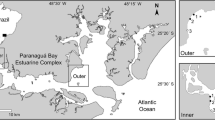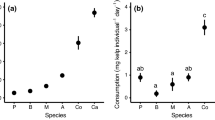Abstract
Permeability of boundaries in biological systems is regulated by biotic and/or abiotic factors. Despite this knowledge, the role of biotic factors in regulating resource transfer across ecosystem boundaries has received little study. Additionally, little is known about how cross-ecosystem resource transfer affects source populations. We used experiments, observations and stable isotopes, to evaluate: (1) the proportion of intertidal-foraging black fire ant (Solenopsis richteri) diet derived from marine sources, (2) how black fire ant cross-ecosystem resource transfer is altered by the dominant bioengineer in the intertidal, a burrowing crab (Neohelice granulata), (3) the top-down impact of these terrestrial ants on a marine resource, and (4) the effect of marine resources on recipient black fire ants. We found that more than 85% of the black fire ant diet is derived from marine sources, the number of intertidal foraging ants doubles in the absence of crab burrows, and that ants cause a 50% reduction in intertidal polychaetes. Also, ant mound density is three times greater adjacent to marine systems. This study reveals that cross-ecosystem foraging terrestrial ants can clearly have strong impacts on marine resources. Furthermore, ecosystem engineers that modify and occupy habitat in these ecosystem boundaries can strongly regulate the degree of cross-ecosystem resource transfer and resultant top down impacts.



Similar content being viewed by others
References
Alberti J, Escapa M, Daleo P, Méndez Casariego A, Iribarne O (2010) Crab bioturbation and herbivory reduce pre- and post-germination success of Sarcocornia perennis in bare patches of SW Atlantic salt marshes. Mar Ecol Prog Ser 400:55–61
Bertness MD (1985) Fiddler crab regulation of Spartina alterniflora production on a New England salt marsh. Ecology 66:1042–1055
Botto F, Iribarne O (1999) Effect of the burrowing crab Chasmagnathus granulata (Dana) on the benthic community of a SW Atlantic coastal lagoon. J Exp Mar Biol Ecol 241:263–284
Botto F, Iribarne O (2000) Contrasting effects of two burrowing crabs (Chasmagnathus granulata and Uca uruguayensis) on sediment composition and transport in estuarine environments. Estuar Coast Shelf Sci 51:141–151
Botto F, Valiela I, Iribarne O, Martinetto P, Alberti J (2005) Impact of burrowing crabs on C and N sources, control, and transformations in sediments and food webs of SW Atlantic estuaries. Mar Ecol Prog Ser 293:155–164
Botto F, Iribarne O, Gutierrez J, Bava J, Gagliardini A, Valiela I (2006) Ecological importance of passive deposition of organic matter into burrows of the SW Atlantic crab Chasmagnathus granulatus. Mar Ecol Prog Ser 312:201–210
Cadenasso ML et al (2003) An interdisciplinary and synthetic approach to ecological boundaries. Bioscience 53:717–722
Carlton JT, Hodder J (2003) Maritime mammals: terrestrial mammals as consumers in marine intertidal communities. Mar Ecol Prog Ser 256:271–286
Crain CM, Bertness MD (2009) Ecosystem engineering across environmental gradients: implications for conservation and management. Bioscience 56:211–218
Daleo P, Fanjul E, Casariego AM, Silliman BR, Bertness MD, Iribarne O (2007) Ecosystem engineers activate mycorrhizal mutualism in salt marshes. Ecol Lett 10:902–908
Escapa M, Iribarne O, Navarro D (2004) Effects of the intertidal burrowing crab Chasmagnathus granulatus on infaunal zonation patterns, tidal behavior, and risk of mortality. Estuaries Coasts 27:120–131
Fanjul E, Grela MA, Iribarne O (2007) Effects of the dominant SW Atlantic intertidal burrowing crab Chasmagnathus granulatus on sediment chemistry and nutrient distribution. Mar Ecol Prog Ser 341:177–190
Fanjul E, Grela MA, Canepuccia A, Iribarne O (2008) The Southwest Atlantic intertidal burrowing crab Neohelice granulata modifies nutrient loads of phreatic waters entering coastal area. Estuar Coast Shelf Sci 79:300–306
Flecker AS (1996) Ecosystem engineering by a dominant detritivore in a diverse tropical stream. Ecology 77:1845–1854
Gaines SD, Bertness MD (1992) Dispersal of juveniles and variable recruitment in sessile marine species. Nature 360:579–580
Gaines S, Roughgarden J (1985) Larval settlement rate: a leading determinant of structure in an ecological community of the marine intertidal zone. Proc Natl Acad Sci USA 82:3707–3711
Gratton C, Donaldson J, Zanden M (2008) Ecosystem linkages between lakes and the surrounding terrestrial landscape in northeast Iceland. Ecosystems 11:764–774
Greenwood MJ, McIntosh AR (2008) Flooding impacts on responses of a riparian consumer to cross-ecosystem subsidies. Ecology 89:1489–1496
Gutiérrez JL et al (2006) The contribution of crab burrow excavation to carbon availability in surficial salt-marsh sediments. Ecosystems 9:647–658
Iribarne O, Bortolus A, Botto F (1997) Between-habitat differences in burrow characteristics and trophic modes in the southwestern Atlantic burrowing crab Chasmagnathus granulata. Mar Ecol Prog Ser 155:137–145
Jones CG, Lawton JH, Shachak M (1994) Organisms as ecosystem engineers. Oikos 69:373–386
Jones CG, Lawton JH, Shachak M (1997) Positive and negative effects of organisms as physical ecosystem engineers. Ecology 78:1946–1957
Kristensen E (2008) Mangrove crabs as ecosystem engineers; with emphasis on sediment processes. J Sea Res 59:30–43
Lajtha K, Michener RH (2007) Stable isotopes in ecology and environmental science, 2nd edn. Blackwell, Oxford
Laurance WF, Didham RK, Power ME (2001) Ecological boundaries: a search for synthesis. Trends Ecol Evol 16:70–71
LeBrun EG, Tillberg CV, Suarez AV, Folgarait PJ, Smith CR, Holway DA (2007) An experimental study of competition between fire ants and Argentine ants in their native range. Ecology 88:63–75
Marczak LB, Hoover TM, Richardson JS (2007a) Trophic interception: how a boundary-foraging organism influences cross-ecosystem fluxes. Oikos 116:1651–1662
Marczak LB, Thompson RM, Richardson JS (2007b) Meta-analysis: trophic level, habitat, and productivity shape the food web effects of resource subsidies. Ecology 88:140–148
Martinetto P, Iribarne O, Palomo G (2005) Effect of fish predation on intertidal benthic fauna is modified by crab bioturbation. J Exp Mar Biol Ecol 318:71–84
Moore JW, Schindler DE, Carter JL, Fox J, Griffiths J, Holtgrieve GW (2007) Biotic control of stream fluxes: spawning salmon drive nutrient and matter export. Ecology 88:1278–1291
Morrison LW, Porter SD, Daniels E, Korzukhin MD (2004) Potential global range expansion of the invasive fire ant, Solenopsis invicta. Biol Invasions 6:183–191
Naiman RJ, Decamps H, Pastor J, Johnston CA (1988) The potential importance of boundaries of fluvial ecosystems. J North Am Benthol Soc 7:289–306
Nakano S, Murakami M (2001) Reciprocal subsidies: dynamic interdependence between terrestrial and aquatic food webs. Proc Natl Acad Sci USA 98:166–170
Nixon SW (1980) Between coastal marshes and coastal waters-a review of 20 years of speculation and reserach on the role of salt marshes in estuarine productivity and water chemistry. In: Hamilton P, Macdonald KB (eds) Estuarine and wetland processes, with emphasis on modeling. Plenum, New York, pp 437–525
Paetzold A, Tockner K (2005) Effects of riparian arthropod predation on the biomass and abundance of aquatic insect emergence. J North Am Benthol Soc 24:395–402
Paetzold A, Schubert CJ, Tockner K (2005) Aquatic terrestrial linkages along a braided-river: riparian arthropods feeding on aquatic insects. Ecosystems 8:748–759
Palomo G, Iribarne O (2000) Sediment bioturbation by polychaete feeding may promote sediment stability. Bull Mar Sci 67:249–257
Palomo G, Botto F, Navarro D, Escapa M, Iribarne O (2003a) Does the presence of the SW Atlantic burrowing crab Chasmagnathus granulatus Dana affect predator-prey interactions between shorebirds and polychaetes? J Exp Mar Biol Ecol 290:211–228
Palomo G, Martinetto P, Perez C, Iribarne O (2003b) Ant predation on intertidal polychaetes in a SW Atlantic estuary. Mar Ecol Prog Ser 253:165–173
Paramor OAL, Hughes RG (2004) The effects of bioturbation and herbivory by the polychaete Nereis diversicolor on loss of saltmarsh in south-east England. J Appl Ecol 41:449–463
Perfecto I (1994) Foraging behavior as a determinant of asymmetric competitive interaction between two ant species in a tropical agroecosystem. Oecologia 98:184–192
Phillips DL, Gregg JW (2001) Uncertainty in source partitioning using stable isotopes. Oecologia 127:171–179
Phillips D, Newsome S, Gregg J (2005) Combining sources in stable isotope mixing models: alternative methods. Oecologia 144:520–527
Polis GA, Hurd SD (1996) Linking marine and terrestrial food webs: allochthonous input from the ocean supports high secondary productivity on small islands and coastal land communities. Am Nat 147:396–423
Polis GA, Anderson WB, Holt RD (1997) Toward an integration of landscape and food web ecology: the dynamics of spatially subsidized food webs. Annu Rev Ecol Syst 28:289–316
Porter SD, Williams DF, Patterson RS, Fowler HG (1997) Intercontinental differences in the abundance of Solenopsis fire ants (Hymenoptera: Formicidae): escape from natural enemies. Environ Entomol 26:373–384
Post DM (2002) Using stable isotopes to estimate trophic position: models, methods, and assumptions. Ecology 83:703–718
Richardson JS, Zhang Y, Marczak LB (2010) Resource subsidies across the land–freshwater interface and responses in recipient communities. River Res Appl 26:55–66
Sanzone DM, Meyer JL, Marti E, Gardiner EP, Tank JL, Grimm NB (2003) Carbon and nitrogen transfer from a desert stream to riparian predators. Oecologia 134:238–250
Showler AT, Knaus RM, Reagan TE (1990) Studies of the territorial dynamics of the red imported fire ant (Solenopsis invicta Buren, Hymenoptera: Formicidae). Agric Ecosyst Environ 30:97–105
Stapp P, Polis GA (2003) Marine resources subsidize insular rodent populations in the Gulf of California, Mexico. Oecologia 134:496–504
Tschinkel WR (1993) Sociometry and sociogenesis of colonies of the fire ant Solenopsis Invicta during one annual cycle. Ecol Monogr 63:425–457
Valiela I, Teal JM, Volkmann S, Shafer D, Carpenter EJ (1978) Nutrient and particulate fluxes in a salt marsh ecosystem: tidal exchanges and inputs by precipitation and groundwater. Limnol Oceanogr 23:798–812
Witman JD, Ellis JC, Anderson WB (2004) The influence of physical processes, organisms and permeability on cross-ecosystem fluxes. In: Polis GA, Power ME, Huxel GR (eds) Food webs at the landscape level. The University of Chicago Press, pp 335–349
Acknowledgments
We thank Andrew Altieri, Fernanda Álvarez, Pedro Daleo, Oscar Iribarne, John Griffin, Craig Layman, Tim Jardine, Andy Suarez, Danielle Warfe and three anonymous reviewers. This work was supported by grants from the National Science Foundation (NSF) DBI-0610312 (to E.A. Garcia), the Mellon Foundation (to M.D. Bertness) and the Ecology program at NSF (to M.D. Bertness and B.R. Silliman).
Author information
Authors and Affiliations
Corresponding author
Electronic supplementary material
Below is the link to the electronic supplementary material.
Rights and permissions
About this article
Cite this article
Garcia, E.A., Bertness, M.D., Alberti, J. et al. Crab regulation of cross-ecosystem resource transfer by marine foraging fire ants. Oecologia 166, 1111–1119 (2011). https://doi.org/10.1007/s00442-011-1952-x
Received:
Accepted:
Published:
Issue Date:
DOI: https://doi.org/10.1007/s00442-011-1952-x




